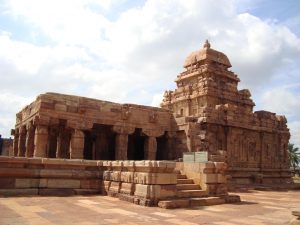ForumIAS announcing GS Foundation Program for UPSC CSE 2025-26 from 27th May. Click Here for more information.
Source-This post on Badami Chalukya has been created based on the article “Badami Chalukya temples, writing found in Nalgonda“published in “THE TIMES OF INDIA” on 23 February 2024.
Why in the news?
Two Badami Chalukya temples, at least 1,300-1,500 years old and a 1,200-year-old label inscription have been recently discovered in Mudimanikyam village along the banks of Krishna.

About Badami Chalukyas
1) Origin– Pulakesi I established the Chalukya dynasty in 550. He took Vatapi (Badami in Bagalkot district, Karnataka) under his control and made it his capital.
Historians refer to Pulakesi I and his descendants as the Chalukyas of Badami.
2) Art and Architecture– It saw the evolution and proliferation of a new style of architecture known as Vesara, a combination of the South Indian and the North Indian building styles.
The rock-cut temples of Pattadakal, a UNESCO World Heritage Site. Badami, and Aihole are the most celebrated monuments
3) Coinage– Their coins had Nagari and Kannada legends. They minted coins with symbols of temples, lion or boar facing right, and the lotus.
4) Religion– They initially followed Vedic Hinduism. Later, from the time of Vikramaditya I, the people took an inclination towards Shaivism, and sects like Pashupata, Kapalikas, and Kalamukhas emerged.
They also patronised Jainism. For ex- Badami cave temples and other Jain temples in the Aihole complex signifies their religious faith.
What was the governance structure of Badami Chalukyas?
1) Defence–
A) The army consisted of infantry, cavalry, elephant corps, and a powerful navy.
B) Hiuen-Tsang mentioned the Chalukya army that had hundreds of elephants, which were intoxicated with liquor prior to the battle.
C) Rashtrakuta inscriptions use the term Karnatabala to refer to their powerful armies.
2) Taxation– The government levied taxes called Herjunka, Kirukula, Bilkode, and Pannaya.
3) Administrative division– The empire was divided into Maharashtrakas (provinces), then into smaller Rashtrakas (Mandala), Vishaya (district), Bhoga (group of ten villages).
4) Local governance– Groups of mahajanas (learned brahmins) looked after agraharas. Agraharas were the place of higher learning.
There were many autonomous regions which were ruled by feudatories like Alupas, Gangas, Banas, and Sendraka.
Read more about- Chalukya dynasty
UPSC Syllabus-Art & Culture




